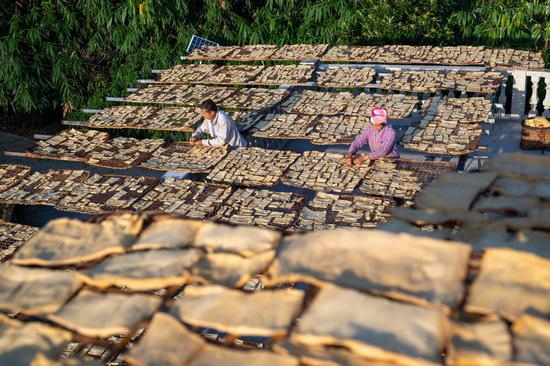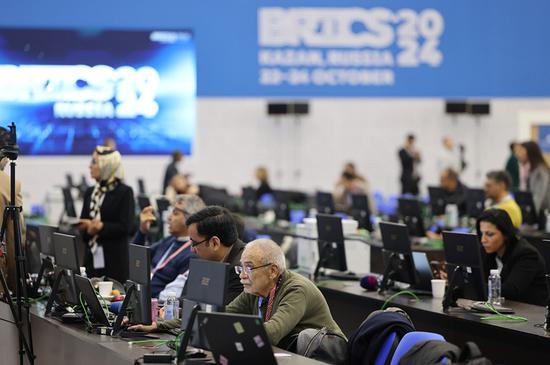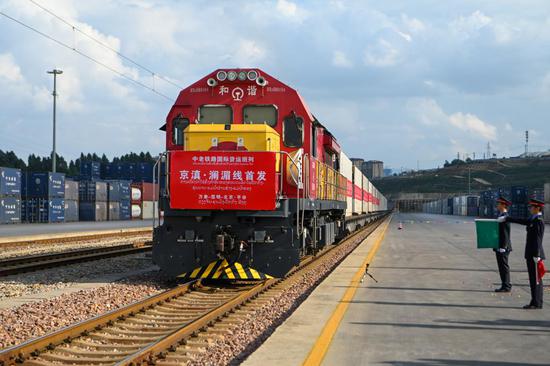
A view of China Merchants Bank's booth during a recent expo in Beijing. (CHINA DAILY)
China's recent introduction of a forceful policy package, which includes support for local governments to resolve debt risks and efforts to stabilize the real estate market, will help mitigate financial risks in the banking sector and steer the economy toward a stable recovery, analysts said.
Although the number of high-risk financial institutions has decreased in recent years, the risks associated with small and medium-sized financial institutions still remain a concern that requires comprehensive measures to tackle, they added.
"A considerable amount of the risks faced by commercial banks, especially city commercial banks, are directly linked to local government debts and the real estate market," said Dong Ximiao, chief researcher at Merchants Union Consumer Finance.
The People's Bank of China, the country's central bank, in late September authorized lenders to cut interest rates on existing mortgages, lowered the interest rate of seven-day reverse repos, a key short-term policy rate, and revised the reserve requirement ratio, the amount of cash that banks are required to have on hand.
These easing measures could alleviate repayment burdens for borrowers, and regulatory forbearance extended to property developers and medium and small-sized enterprises could also help mitigate near-term default risks, said Elaine Xu, director of Asia-Pacific Financial Institution at Fitch Ratings.
This is particularly the case for small regional banks as they tend to have higher exposure to developers, local government financing vehicles and MSEs, Xu said.
Due to shifting market liquidity, major State-owned banks trimmed their deposit interest rates on Oct 18, with many smaller commercial banks following suit recently.
Although it is difficult to fully offset for the decline in net interest margins due to lower existing mortgage loan rates, the deposit rate reductions will help alleviate the pressure on commercial banks' funding costs and interest rate spreads, Dong said.
Analysts expect that there is still some room for deposit interest rates to decline further, which would help alleviate the pressure from narrowing interest margins and ensure the stable operations of commercial banks, enabling them to continue increasing their financing support for the real economy.
On top of this, the Ministry of Finance announced its plan in mid-October to increase the debt ceiling on a relatively large scale in a one-time move, to replace existing hidden debts of local governments.
As of June, China's total local government debt amounted to about 100 trillion yuan ($14 trillion), with local government bonds accounting for 42.23 trillion yuan and LGFV interest-bearing debt came in at 57.16 trillion yuan, said Li Jianjun, vice-president of Central University of Finance and Economics, at the Annual Conference of Financial Street Forum 2024 in Beijing earlier this month.
The government's heightened efforts to address local government debt risks may lead to a slight near-term drag on banks' interest rate margins due to their involvement in debt swap programs, as China Galaxy Securities stated in its report.
However, the long-term benefits for banks will outweigh the short-term impact, as banks are set to gain in the long run from the clearance of nonperforming assets and the improvement in local economic fundamentals, according to the report.
The forceful one-two punch will greatly shore up business sentiments and facilitate economic recovery, and set the stage for addressing the risks faced by financial institutions, especially smaller ones, analysts said.
In addition, China authorities have increased capital replenishment through special purpose bonds for weak smaller banks in recent years. However, the improvement for small banks' overall capital adequacy remained marginal and was largely offset by those banks' growth appetite and weak profitability, said Xu of Fitch Ratings.
"We expect consolidation among small banks to be the main approach to addressing near-term risks, which may ease the burden on regulatory oversight," Xu said.
That said, this alone may not permanently address the risks that small banks face, as the surviving entities still face significant pressure from economic headwinds, Xu added.
Sustainable capital replenishment mechanisms should be in place to enhance the resilience of small and medium-sized banks and enable them to better serve the real economy, said Dong of Merchants Union Consumer Finance.
This involves appropriately optimizing shareholder eligibility conditions and simplifying approval processes to facilitate qualified shareholders' capital injections, Dong said, adding that relaxing access conditions to support small and medium-sized banks' issuance of preferred shares, perpetual bonds and convertible bonds is also a viable option.


















































 京公网安备 11010202009201号
京公网安备 11010202009201号